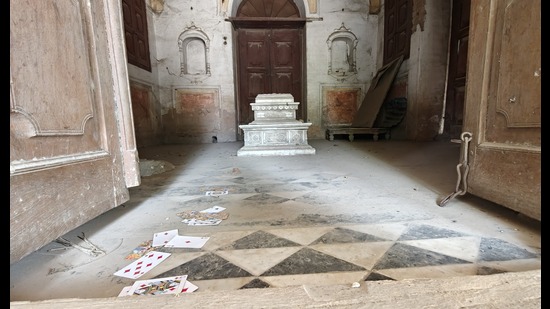Unprotected heritage scripts another chapter in book of neglect
Baba Hazara Bagh, Nawabi-era memorial to a spiritual leader from Punjab, lies in disrepair in Old Lucknow
: Like many other landmarks in Old Lucknow, neglect is all too evident at the Baba Hazara Bagh, an 18th century memorial dedicated to a religious leader with roots in Punjab, as the world celebrates International Day for Monuments and Sites, also known as World Heritage Day on Friday.

Situated in Thakurganj, the structure was built during the Nawabi period between 1756-1775, historians say. A boundary wall surrounds the complex, which includes temples, houses and eight memorials. Three of these memorials have corridors, but the rest have small octagonal rooms.
During Nawab Shuja-ud-Daula’s reign, Baba Hazara, a Nanak Udasin spiritual leader from the Hazara hamlet in Jalandhar, Punjab, paid a visit to this location.
According to a booklet published by the Sangat in 1984, which is based on a lyrical narrative of Mata Prasad Naisha titled ‘Baba Hazara ki Badshahi’ published in 1929, Baba Hazara is said to have breathed his last under a neem tree in 1799 and his samadhi (memorial) was erected at this site. Adjoining it is his successor’s samadhi, that of Baba Amriti Das, who had built the samadhi of his guru.
Despite its obvious poor state, the structure is not yet under the care of any state or central protecting body like Archeological Survey of India or the state archaelogy department, which usually looks after such heritage monuments.
“Its ownership is not with us,” Aftab Hussain, superintending officer, ASI, Lucknow Circle, said.
Renu Dwivedi, director of UP State archaelogy department, too, said the structure does not come under their jurisdiction.
After HT spoke with some tenants living inside the complex and city historians, they said monument is taken care of by a trust or association/ Baba’s disciples belonging to a Sangat.
When HT team visited the site, there were garbage piles at the entrance, symbolic of the general state of disrepair of the monument itself.
“It’s disheartening to witness such a significant piece of our heritage, languishing in this manner. We owe it to our past and future generations to protect these treasures. Living in Lucknow, it isn’t just a historical site on a map; it’s a part of my childhood memories but walking past it now fills me with disappointment,” said Swapnil Rastogi, a resident and heritage enthusiast.
The entire neighbourhood is currently in disarray due to a lack of attention.
“The land grant was given to the Baba and his followers during Nawabi rule, possibly by Shuja-ud-Daula or Asaf-ud-Daula due to certain miracles, which were attributed to the holy man, then in Lucknow,” said city-based historian PC Sarkar.
On Vijaydashami, huge effigies of Ravana and Meghnad are set ablaze here at sunset, according to historians.
Three days later, to mark Lord Ram’s Raj tilak abhishek, a cultural programme is performed throughout the night by a troupe from Mathura and Vrindavan.
A ‘kothi’ at the site is adorned with a a double-storeyed entrance bearing the symbolic fish pair motif of Awadh. The grand baradaris have stucco mouldings and stone brackets carved in the shape of elephant heads, fixed all around the exterior (to support the overhanging stones that are in use as sun shades). The Samadhi rooms are richly decorated with floral patterns and idols that are mounted overhead.






